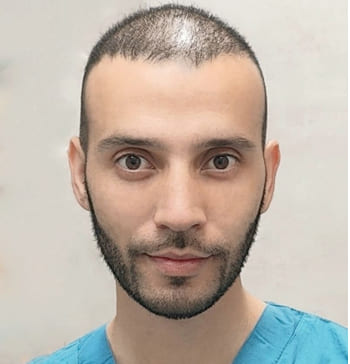
БАЛЬСОПРИМ 26,6 мг/мл + 5,4 мг/мл + 0,5 мг/мл ОРАЛЬНА СУСПЕНЗІЯ
Запитайте лікаря про рецепт на БАЛЬСОПРИМ 26,6 мг/мл + 5,4 мг/мл + 0,5 мг/мл ОРАЛЬНА СУСПЕНЗІЯ

Інструкція із застосування БАЛЬСОПРИМ 26,6 мг/мл + 5,4 мг/мл + 0,5 мг/мл ОРАЛЬНА СУСПЕНЗІЯ
Введення
Опис:інформація для пацієнта
БАЛСОПРИМ 26,6МГ/МЛ+5,4МГ/МЛ+0,5МГ/МЛ СУСПЕНЗІЯ ДЛЯ ПЕРОРАЛЬНОГО ВЖИТТЯ
Сульфаметоксазол / триметоприм / бромгексин гідрохлорид
Прочитайте уважно весь опис перед тим, як почнете приймати цей лікарський засіб,адже він містить важливу інформацію для вас.
- Збережіть цей опис, оскільки вам може знадобитися знову його прочитати.
- Якщо у вас виникли питання, проконсультуйтеся з вашим лікарем, фармацевтом або медсестрою.
- Цей лікарський засіб призначений тільки вам, і його не слід давати іншим людям, навіть якщо вони мають такі самі симптоми, як у вас, оскільки це може їм нашкодити.
- Якщо ви відчуваєте побічні ефекти, проконсультуйтеся з вашим лікарем, фармацевтом або медсестрою, навіть якщо це побічні ефекти, які не вказані в цьому описі. Див. розділ 4
Зміст опису
- Що таке Балсоприм і для чого він використовується
- Що потрібно знати перед тим, як почати приймати Балсоприм
- Як приймати Балсоприм
- Можливі побічні ефекти
5 Зберігання Балсоприму
- Зміст упаковки та додаткова інформація
1. Що таке Балсоприм і для чого він використовується
 Балсоприм - це антибіотик, який усуває бактерії, які викликають інфекції. Він містить два різних лікарських засоби - триметоприм і сульфаметоксазол (сульфонамід). Крім того, він містить бромгексин, лікарський засіб з муколітичною дією.
Балсоприм - це антибіотик, який усуває бактерії, які викликають інфекції. Він містить два різних лікарських засоби - триметоприм і сульфаметоксазол (сульфонамід). Крім того, він містить бромгексин, лікарський засіб з муколітичною дією.
Балсоприм призначений для дорослих, підлітків і дітей (2-11 років) для лікування наступних інфекцій, які також потребують комбінованої дії муколітика:
- Гостре загострення хронічного бронхіту у пацієнтів без факторів ризику.
Також він призначений у випадках, коли використання звичайних антибактеріальних засобів для первинного лікування цієї інфекції вважається невідповідним:
- Гостре запалення середнього вуха (гостре отит)
- Гостре бактеріальне запалення синусів
2. Що потрібно знати перед тим, як почати приймати Балсоприм.
Не приймайте Балсоприм
- якщо ви алергічні на сульфаметоксазол, триметоприм, бромгексин або на будь-який інший компонент цього лікарського засобу, вказаний у розділі 6.
- У разі дітей молодших 2 років.
- Якщо ви страждаєте на гостру порфірію (хворобу крові, при якій не виробляється достатньо гемоглобіну).
- У поєднанні з dofetilidою (лікарським засобом, який використовується для контролю нерегулярних або швидких серцевих скорочень).
- Якщо ви вагітні або підозрюєте, що можете бути вагітною, або якщо ви годуєте грудьми
Попередження та застереження
Проконсультуйтеся з вашим лікарем або фармацевтом перед тим, як почати приймати Балсоприм.
- У пацієнтів похилого віку, оскільки вони з більшою ймовірністю можуть відчувати серйозні побічні ефекти.
- Якщо ви приймаєте Балсоприм тривалий час або якщо у вас є дефіцит фолієвої кислоти або ви пацієнт похилого віку, ваш лікар може призначити аналіз крові для проведення гематологічних досліджень.
- Балсоприм може впливати на результати деяких лабораторних тестів.
- Якщо ви страждаєте на фенілкетонурію (метаболічну хворобу, яка впливає на фермент фенілаланін), оскільки прийом триметоприму змінює метаболізм фенілаланіну. Це не становить проблеми у пацієнтів з відповідною дієтою.
- Якщо ви страждаєте на дефіцит ферменту глюкози-6-фосфатдегідрогенази (G-6-PD).
- Якщо у вас є ризик гіперкаліємії (високого рівня калію) та гіпонатріємії (низького рівня натрію) ваш лікар буде вважати необхідність контролю калію та натрію в крові.
- Балсоприм не повинен використовуватися для лікування фарингіту, викликаного бета-гемолітичним стрептококом групи А (S. pyogenes).
- Через муколітичні властивості бромгексину та здатність порушувати мукозний бар'єр травної системи, його слід застосовувати з обережністю у пацієнтів з історією виразкової хвороби, через ризик кровотечі.
- Як наслідок колонізації Clostridium difficile, використання Балсоприму може рідко призвести до розвитку псевдомембранозного коліту, який проявляється через діарею.
- Якщо у вас є проблеми з нирками (відомий нирковий дефіцит). Ваш лікар повинен вжити спеціальні заходи. Для забезпечення адекватної ниркової елімінації слід забезпечити достатнє водне навантаження пацієнта та підтримувати нормальний рівень pH сечі, уникати кислотифікації сечі.
- Якщо у вас є проблеми з печінкою (тяжка травма паренхіми печінки).
- Котримоксазол був застосований у пацієнтів, які приймають цитотоксичні препарати, з мінімальними або відсутніми додатковими ефектами на кістковий мозок або периферичну кров.
- На початку лікування рідіння та мобілізація секретів може частково обструктувати бронхи, що буде помітно зменшуватися протягом лікування.
- Якщо ви відчуваєте несподіване погіршення кашлю та короткості дыхання, негайно повідомте про це вашому лікареві.
- Якщо у вас є тяжкі порушення крові, крім випадків, коли існує тісний лікарський контроль.
Відбулися випадки смерті, викликані серйозними реакціями, включаючи гостру печінкову некроз, агранулоцитоз, апластичну анемію, інші порушення крові та гіперчутливість дихальної системи.
Відбулися рідкі випадки важких шкірних висипань, пов'язаних з прийомом котримоксазолу, які можуть загрожувати життю пацієнта (синдром Стівенса-Джонсона, токсичний епідермальний некроліз, гостра генералізована пустульозна екзантема та гостра фебрильна нейтрофільна дерматоз або синдром Світта) з початковим застосуванням Балсоприму, які з'являються як червоні або круглі плями, часто з центральною пухлиною. Інші додаткові симптоми, які можуть з'явитися, - це виразки у роті, горлі, носі, геніталіях та кон'юнктивіт (опухлі та червоні очі). Ці шкірні висипання, які можуть загрожувати життю пацієнта, часто супроводжуються симптомами грипу. Висипання на шкірі можуть прогресувати до утворення пухлин або лущення шкіри.
Період найбільшого ризику появи серйозних шкірних реакцій припадає на перші тижні лікування.
Якщо ви розвинули висипання або синдром Стівенса-Джонсона, токсичний епідермальний некроліз або гостру фебрильну нейтрофільну дерматоз з прийомом Балсоприму, не слід знову приймати Балсоприм, зверніться до лікаря та повідомте йому про це.
Якщо ви відчуваєте серйозну шкірну реакцію: червону та лущену висипання з пухлинами під шкірою та пухлинами (гостра генералізована пустульозна екзантема), негайно зверніться до лікаря та повідомте йому, що ви приймаєте цей лікарський засіб.
Відбулися повідомлення про серйозні шкірні реакції, пов'язані з прийомом бромгексину. Якщо у вас з'явилася шкірна висипання (включаючи ураження слизових оболонок, наприклад, рота, горла, носа, очей та геніталій), припиніть використання Балсоприму та негайно зверніться до лікаря.
Відбулися рідкі випадки реакцій гіперчутливості з еозинофілією (збільшенням кількості певного типу білих кров'яних клітин) та системними симптомами, пов'язаними з прийомом Балсоприму.
Дихальна токсичність
Під час лікування котримоксазолом відзначалися рідкі та серйозні випадки дихальної токсичності, які іноді призводять до синдрому гострої дихальної недостатності (ГДН). Поява дихальних симптомів, таких як кашель, гарячка та короткість дыхання, у поєднанні з радіологічними ознаками інфільтрації легень та порушення функції легень, можуть бути попередніми ознаками ГДН. У таких випадках слід припинити прийом котримоксазолу та провести відповідне лікування.
Лімфогістіоцитоз, пов'язаний з гемофагоцитозом
Відбулися рідкі випадки надмірних імунних реакцій через неконтрольовану активацію білих кров'яних клітин, які викликають запалення (лімфогістіоцитоз, пов'язаний з гемофагоцитозом), які можуть бути потенційно смертельними, якщо не діагностовані та не лікуються своєчасно. Якщо ви відчуваєте множинні симптоми, такі як гарячка, збільшення лімфатичних вузлів, відчуття слабкості, головокружіння, короткість дыхання, синяки або шкірна висипання, зверніться до лікаря негайно.
Діти
- У дітей віком від 2 до 6 років слід оцінити співвідношення ризику та користі.
Інші лікарські засоби та Балсоприм
Повідомте вашому лікареві або фармацевту, якщо ви приймаєте, нещодавно приймали або можете приймати інші лікарські засоби.
Балсоприм може посилювати дію та/або токсичність деяких лікарських засобів. важливо повідомити вашому лікареві, якщо ви приймаєте або нещодавно приймали будь-який з наступних лікарських засобів:
- Лікарські засоби, які використовуються для контролю серцевого ритму (антиаритмічні засоби класу III), такі як dofetilida. Відзначалися підвищені рівні dofetilidi після спільного прийому з триметопримом. (Див. розділ 2 Не приймайте Балсоприм).
- Лікарські засоби, які використовуються для збільшення виділення сечі: діуретики (особливо тіазиди). Спільне застосування діуретиків з триметопримом/сульфаметоксазолом у пацієнтів похилого віку може збільшити ризик тромбоцитопенії (зниження кількості тромбоцитів) та гіпонатріємії (низького рівня натрію).
- Лікарські засоби, які використовуються для антикоагуляції, такі як варфарин. Триметоприм/сульфаметоксазол посилює антикоагуляційну дію варфарину. Рекомендується ретельний контроль антикоагуляційного лікування під час прийому Балсоприму.
- Деякі лікарські засоби, які використовуються для контролю рівня цукру в крові: пероральні гіпоглікемічні засоби (сульфонілуреа).
- Лікарські засоби, які використовуються для лікування серцевих захворювань (дигоксин). Спільне застосування триметоприму та дигоксину показало збільшення рівня дигоксину у деяких пацієнтів похилого віку.
- Лікарські засоби, які використовуються для лікування інфекцій, викликаних деякими паразитами (піриметамін). Спільне застосування триметоприму/сульфаметоксазолу з дозами піриметаміну понад 25 мг на тиждень може призвести до розвитку мегалобластної анемії (зниження кількості червоних кров'яних клітин та збільшення їхнього розміру).
- Деякі лікарські засоби, які використовуються для лікування ВІЛ-інфекції: антиретровірусні засоби (ламівудин, зідовудин). Спільне лікування Балсопримом та зідовудином може збільшити ризик гематологічних побічних ефектів триметоприму/сульфаметоксазолу, тому слід проводити моніторинг параметрів крові.
- Лікарські засоби, які є антагоністами фолієвої кислоти, такими як фенітойн (використовується для лікування епілепсії) та метотрексат (використовується для лікування різних видів раку та також для лікування ревматоїдного артриту). Якщо триметоприм/сульфаметоксазол застосовується разом з фенітойном, слід враховувати надмірну дію фенітойну. Якщо Балсоприм застосовується з метотрексатом, слід розглянути можливість призначення фолієвої кислоти.
- Лікарські засоби, які використовуються для трансплантації: імунодепресанти (циклоспорин). У пацієнтів, які приймають триметоприм/сульфаметоксазол та циклоспорин, відзначався тимчасовий порушення функції нирок після трансплантації нирки.
- Лікарські засоби, які можуть викликати гіперкаліємію (збільшення рівня калію в крові).
- Антибіотики: Спільне застосування бромгексину та антибіотиків (таких як амоксиліна, окситетрацикліну та еритроміцину) збільшує концентрацію цих антибіотиків у легеневому тканині. Однак не доведено клінічну значимість цієї взаємодії.
- Лікарські засоби, які використовуються як антикашльові засоби: Спільне застосування антикашльових засобів (антіколінергічних засобів, антигістамінних засобів тощо) може призвести до інгібування кашльового рефлексу та викликати застій рідини, яку виділяє бромгексин.
При спільному застосуванні триметоприму з лікарськими засобами, такими як прокаїнамід, амантадин, існує можливість збільшення концентрації одного або обох лікарських засобів у плазмі крові.
Інші взаємодії
- Антиаритмічні засоби та інші лікарські засоби, які впливають на інтервал QT
- Рифампіцин та дапсон
- Фенілаланін
- Трициклічні антидепресанти та інші інгібітори бронхіальної секреції
Прийом Балсоприму з їжею, напоями та алкоголем
- Слід уникати вживання алкоголю під час лікування Балсопримом
- Слід бути обережним у пацієнтів з дієтами, багаті на калію.
Вагітність,годування грудьмита фертильність
Якщо ви вагітні або годуєте грудьми, підозрюєте, що можете бути вагітною або плануєте вагітність, проконсультуйтеся з вашим лікарем або фармацевтом перед тим, як приймати цей лікарський засіб.
Триметоприм та сульфаметоксазол проникають через плаценту, і їхня безпека для вагітних жінок не встановлена. Триметоприм/сульфаметоксазол слід уникати під час вагітності, якщо тільки потенційна користь для матері не переважує потенційний ризик для плода, можна розглянути призначення фолієвої кислоти у високих дозах (до 4-5 мг/добу) під час вагітності.
Якщо Балсоприм застосовується матері перед пологами, існує теоретичний ризик кірніктерусу (важкої неврологічної ускладнення через підвищення рівня білірубіну в крові) у новонародженого. Цей теоретичний ризик особливо важливий для дітей з підвищеним ризиком гіпербілірубінемії, таких як недоношені або з дефіцитом глюкози-6-фосфатдегідрогенази.
Прийом триметоприму/сульфаметоксазолу слід уникати на кінцевих стадіях вагітності та у годуючих матерів, коли матері або діти мають або знаходяться під особливим ризиком розвитку гіпербілірубінемії
Бромгексин проникає через плацентарний бар'єр. Немає достатніх передклінічних даних про тератогенез. У клінічній практиці спостереження за вагітними, які приймали бромгексин, недостатнє для повного виключення ризику.
Отже, як заходи обережності, не слід застосовувати Балсоприм під час вагітності, якщо тільки потенційна користь для матері не переважує потенційний ризик для плода, можна розглянути призначення фолієвої кислоти у високих дозах (до 4-5 мг/добу) під час вагітності.
Годування грудьми
Триметоприм та сульфаметоксазол виділяються з грудним молоком.
Не слід приймати Балсоприм під час годування грудьми.
Фертильність
Не проводилися дослідження щодо впливу Балсоприму на людську фертильність.
На основі доступного передклінічного досвіду, при звичайних дозах немає ознак можливого впливу на фертильність через використання бромгексину.
Водіння транспортних засобів та використання машин
Під час лікування Балсопримом іноді можуть спостерігатися головокружіння через дію бромгексину, що слід враховувати при водінні транспортних засобів або використанні небезпечних машин.
Балсоприм містить пара-гідроксибензоат пропілу та пара-гідроксибензоат метилу
Може викликати алергічні реакції (можливо, із затримкою)
Балсоприм містить сорбітол
Цей лікарський засіб містить 191,10 мг сорбітолу (Е-420) у кожному мл. Сорбітол є джерелом фруктози. Якщо ваш лікар вказав вам (або вашому дитині), що ви страждаєте на непереносимість певних цукрів, або якщо в вас діагностована спадкова непереносимість фруктози (СНФ), рідка генетична хвороба, при якій пацієнт не може розщеплювати фруктозу, проконсультуйтеся з вашим лікарем перед прийомом цього лікарського засобу. Сорбітол може викликати розлади шлунково-кишкового тракту та легкий проносний ефект.
Балсоприм містить натрій
Цей лікарський засіб містить 68,6 мг натрію (основної складової кухонної солі) у кожній дозі 20 мл (3,43 мг натрію на мл). Це відповідає 3,43% від максимальної добової норми споживання натрію, рекомендованої для дорослих.
Балсоприм містить пропіленгліколь
Цей лікарський засіб містить 2,02 мг пропіленгліколю у кожному мл. Якщо ваша дитина молодша 4 тижнів, проконсультуйтеся з вашим лікарем або фармацевтом, особливо якщо вашій дитині призначені інші лікарські засоби, які містять пропіленгліколь або алкоголь.
3. Як приймати Балсопрім.
Слідкуйте точно інструкціям щодо прийому цього лікарського засобу, вказаним вашим лікарем. У разі сумнівів проконсультуйтеся знову з вашим лікарем або фармацевтом.
Пам'ятайте приймати свій лікарський засіб. Ваш лікар призначить тривалість лікування Балсопрімом. Не припиняйте лікування раніше.
Балсопрім слід приймати переважно після їжі. Рекомендується добре встряхнути перед використанням.
Якщо клінічна поліпшення не є очевидною після 7 днів лікування, проконсультуйтеся з вашим лікарем.
Дорослі
Стандартна доза для дорослих становить 20 мл тричі на день, що відповідає 324 мг триметоприму/ 1596 мг сульфаметоксазолу/ 30 мг бромгексину/ добу
Використання у дітейі підлітків
Педіатричне населення
- Діти старші 12 років і підлітки: Рекомендована доза для дітей старших 12 років становить 20 мл тричі на день, що відповідає 324 мг триметоприму/1596 мг сульфаметоксазолу/30 мг бромгексину/ добу.
- Діти від 6 до 12 років: Рекомендована доза для дітей від 6 до 12 років становить 10 мл тричі на день, що відповідає 162 мг триметоприму/798 мг сульфаметоксазолу/15 мг бромгексину/ добу
- Діти від 2 до 6 років: Рекомендована доза для дітей від 2 до 6 років становить 5 мл тричі на день, що відповідає 81 мг триметоприму/399 мг сульфаметоксазолу/7,5 мг бромгексину/ добу.
Вік дитини | Доза |
>12 років | 20 мл 3 рази на день |
Від 6 до 12 років | 10 мл 3 рази на день |
Від 2 до 6 років | 5 мл 3 рази на день |
<2 роки< p> | Протипоказано |
Пацієнти похилого віку
Балсопрім слід застосовувати з обережністю у пацієнтів похилого віку. Якщо не вказано іншу дозу, слід використовувати стандартну дозу.
Пацієнти з нирковою недостатністю
Дорослі та діти старші 12 років (немає даних для дітей молодших 12 років):
Кліренс креатиніну (мл/хв) | Доза |
> 30 | Стандартна доза |
15-30 | Половина стандартної дози |
<15 | Не рекомендується |
Рекомендується проводити вимірювання концентрації сульфаметоксазолу в плазмі крові з інтервалом 2-3 дні у зразках, отриманих через 12 годин після прийому Балсопріму. Якщо концентрація сульфаметоксазолу перевищує 150 мкг/мл, лікування слід припинити до тих пір, поки значення не буде нижче 120 мкг/мл.
Пацієнти з порушеннями функції печінки
Балсопрім слід застосовувати з обережністю у пацієнтів з порушеннями функції печінки.
Якщо ви прийняли більше Балсопріму, ніж потрібно
Симптоми передозування найчастіше включають нудоту, блювоту, вертіго та сплутаність свідомості.
При гострій передозуванні триметопримом спостерігалося пригнічення кісткового мозку.
У разі відсутності блювоти його слід викликати. Слід проводити промивання шлунка. У залежності від стану ниркової функції рекомендується введення рідини, якщо виділення з сечею низьке. Обидва речовини, триметоприм і сульфаметоксазол, видаляються під час гемодіалізу. Перитонеальний діаліз неефективний
У разі передозування або випадкового прийому лікарського засобу слід звернутися до Токсикологічної служби. Телефон 91 562 04 20, вказуючи лікарський засіб та кількість, прийняту
Якщо ви забули прийняти Балсопрім
Не приймайте подвійну дозу для компенсації забутих доз.
4. Можливі побічні ефекти
Як і всі лікарські засоби, цей лікарський засіб може викликати побічні ефекти, хоча не всі люди їх відчувають.
Побічні ефекти Балсопріму класифікуються за частотою та наступні:
Дуже часті (можуть впливати на більше 1 з 10 осіб)
- Гіперкаліємія (підвищений рівень калію в крові).
Часті (можуть впливати до 1 з 10 осіб)
- Кандидоз (збільшення кількості грибка кандида)
- Головний біль, нудота, діарея
- Висипання на шкірі
Нечасті (можуть впливати до 1 з 100 осіб)
- Блювота
- Біль у верхній частині живота
Рідкі (можуть впливати до 1 з 1000 осіб)
- Алергічні реакції
- Висипання на шкірі, уртикарний висип, кропив'янка
- Алергічні реакції з еозинофілією (збільшенням кількості певного типу білих кров'яних тілець) та системними симптомами
- Бронхоспазм (звуження бронхів)
Дуже рідкі (можуть впливати до 1 з 10 000 осіб)
- Лейкопенія (зниження кількості білих кров'яних тілець)
- Нейтропенія (зниження кількості певного типу білих кров'яних тілець)
- Тромбоцитопенія (зниження кількості тромбоцитів)
- Агранулоцитоз (зниження кількості певного типу білих кров'яних тілець)
- Мегалобластна анемія (зниження кількості червоних кров'яних тілець та збільшення їхнього розміру), апластична анемія (недостатня робота кісткового мозку), гемолітична анемія (зниження кількості червоних кров'яних тілець)
- Метгемоглобінемія (нездатність гемоглобіну переносити кисень)
- Еозинофілія (підвищена кількість певного типу білих кров'яних тілець)
- Пурпура (червоні плями на шкірі), гемоліз (розпад червоних кров'яних тілець) у певних пацієнтів з дефектом Г-6-ПД
- Захворювання серуму (алергічна реакція, подібна до алергії)
- Алергічна міокардит (алергічна реакція, що впливає на серце)
- Лихоманка
- Алергічна васкуліт, подібна до пурпури Шенлейна-Геноха (запалення, що впливає на дрібні вени)
- Періартеріїт вузловий (запалення судин)
- Системний червоний вовчак (автоімунне захворювання)
- Гіпоглікемія (зниження рівня цукру в крові)
- Зниження апетиту
- Гіпонатрімія (зниження рівня натрію в крові)
- Депресія
- Галюцинації
- Асеپтичний менінгіт
- Конвульсії
- Нейрит периферичний (ушкодження та розлад нервів, що призводить до втрати чутливості в руках або втрати сили в м'язах), атаксія (втрата координації)
- Вертіго, звук у вухах
- Увеїт (запалення ока)
- Кашель
- Затруднення дихання, інфільтрати в легенях
- Глосит (запалення мови)
- Стоматит (порушення в роті)
- Псевдомембранозний коліт (запалення товстої кишки)
- Панкреатит (запалення підшлункової залози)
- Розлади печінки та жовчевих шляхів (порушення функції печінки) такі як підвищення рівня трансаміназ (ферментів печінки), підвищення рівня білірубіну в крові, жовтяниця або некроз печінки.
- Фоточутливість (реакція шкіри на світло)
- Ексфоліативний дерматит (важке запалення всієї поверхні шкіри)
- Висипання, викликані лікарськими засобами (алергічна реакція)
- Артралгія (біль у суглобах), міалгія (біль у м'язах)
- Порушення функції нирок
- Нефрит тубулоінтерстиційний (запалення певної частини нирки)
Дуже рідкі побічні ефекти, пов'язані з лікуванням пневмонії, викликаної Pneumocystis jiroveci (P.carinii):
- Важкі алергічні реакції
- Висипання
- Лихоманка
- Нейтропенія (зниження кількості певного типу білих кров'яних тілець)
- Тромбоцитопенія (зниження кількості тромбоцитів)
- Збільшення рівня ферментів печінки
- Гіперкаліємія (підвищений рівень калію в крові)
- Гіпонатрімія (зниження рівня натрію в крові)
- Рабдоміоліз (знищення або запалення м'язів, що супроводжується сильним болем у м'язах та слабкістю)
Частота невідома (не може бути оцінена на основі наявних даних)
- Анафілактичні реакції, такі як анафілактичний шок, ангіоневротичний едем (швидке збільшення шкіри, підшкірних тканин, слизових оболонок або підслизових тканин) та свербіж
- Головокружіння
- Паління в животі
- Висипання на шкірі, що можуть загрожувати життю пацієнта, такі як еритема багатокільчаста (алергічна реакція, що впливає на шкіру), синдром Стівенса-Джонсона/токсична епідермальна некроліз (поширення пухирців та водянистого висипання на шкірі), гостра генералізована пустулозна екзантема (червоне та лущене висипання з пухирцями під шкірою та водянистим висипанням)
- Язви червоного кольору, підвищені та болісні, на кінцівках та іноді на обличчі та шиї, з лихоманкою (синдром Світта)
Важкі побічні ефекти
Натисніть на номер екстреної служби негайно, якщо ви відчуваєте кілька симптомів, таких як лихоманка, низький тиск або підвищення частоти серцевих скорочень після прийому цього лікарського засобу, оскільки це може бути симптомом шоку.
Зверніться до лікаря якнайшвидше, якщо ви відчуваєте важку алергічну реакцію (див. розділ 2: попередження та попередження).
Якщо ви відчуваєте побічні ефекти, зверніться до свого лікаря або фармацевта, навіть якщо це побічні ефекти, які не вказані в цьому листку-вкладиші.
Звіт про побічні ефекти
Якщо ви відчуваєте будь-які побічні ефекти, зверніться до свого лікаря або фармацевта, навіть якщо це можливі побічні ефекти, які не вказані в цьому листку-вкладиші. Ви також можете повідомити про них безпосередньо через Іспанську систему фармакологічного нагляду за лікарськими засобами для людини: www.notificaram.es. Надсилаючи повідомлення про побічні ефекти, ви можете допомогти надати більше інформації про безпеку цього лікарського засобу.
5. Зберігання Балсопріму
Не потребує особливих умов зберігання.
Тримайте цей лікарський засіб поза зором та досягненням дітей.
Не використовуйте цей лікарський засіб після закінчення терміну придатності, вказаного на упаковці після CAD. Термін придатності - останній день місяця, вказаного.
Лікарські засоби не повинні викидатися у водопровідні труби чи сміття. Відкладайте упаковки та лікарські засоби, які вам не потрібні, у пункті збору фармацевтичних відходів. Зверніться до свого фармацевта, щоб дізнатися, як позбутися упаковок та лікарських засобів, які вам вже не потрібні. Таким чином, ви допоможете захистити навколишнє середовище.
6. Зміст упаковки та додаткова інформація
Склад Балсопріму
- Активні речовини - сульфаметоксазол, триметоприм, бромгексин гідрохлорид
- Інші допоміжні речовини
- Карбоксиметилцелюлоза натрію (Е466)
- Мікрокристалічна целюлоза (Е460)
- Гідроксид натрію (Е524)
- Пара-гідроксибензоат метилу (Е218)
- Пара-гідроксибензоат пропілу (Е216)
- Цитринова кислота моногідрат (Е330)
- Полісорбат 80 (Е433)
- Диметикон (Е900)
- Сорбітол 70% (Е420)
- Сахарин натрію (Е954)
- Аромат банана (85509H) (містить пропіленгліколь)
- Куркума (Е100)
- Очищена вода.
Вигляд продукту та вміст упаковки
Балсопрім 26,6мг/мл+5,4мг/мл+0,5мг/мл суспензія для перорального прийому випускається у скляних флаконах по 150 мл та з мірним ковшем.
Уповноважений на отримання дозволу на торгівлю та відповідальний за виробництво
Уповноважений на отримання дозволу на торгівлю
DESMA Laboratorio Farmacéutico SL
Paseo de la Castellana 121, Escalera Izquierda 3ºB
28046 Madrid
Телефон: +34 91 3238792
Факс: +34 91 323 21 05
Відповідальний за виробництво
Laboratorio Farmaceutico SIT S.r.l.
Via Provinciale per Lecco, 78 - 22038 Tavernerio (CO) – Італія
Дата останнього перегляду цьогопроспекту: Липень 2025
Детальна та актуальна інформація про цей лікарський засіб доступна на сайті Іспанського агентства лікарських засобів та медичних продуктів (AEMPS) http://www.aemps.gob.es/-
- Країна реєстрації
- Діючі речовини
- Потрібен рецептТак
- Виробник
- Інформація є довідковою і не є медичною порадою. Перед прийомом будь-яких препаратів обов'язково проконсультуйтеся з лікарем. Oladoctor не несе відповідальності за медичні рішення, прийняті на основі цього контенту.
- Альтернативи до БАЛЬСОПРИМ 26,6 мг/мл + 5,4 мг/мл + 0,5 мг/мл ОРАЛЬНА СУСПЕНЗІЯПотрібен рецептВиробник: Faes Farma S.A.Потрібен рецептФорма випуску: ОРАЛЬНИЙ РОЗЧИН/СУСПЕНЗІЯ, 7 мг/млДіючі речовини: Hederae helicis foliumВиробник: Engelhard Arzneimittel Gmbh & Co. KgНе потрібен рецепт
Лікарі онлайн щодо БАЛЬСОПРИМ 26,6 мг/мл + 5,4 мг/мл + 0,5 мг/мл ОРАЛЬНА СУСПЕНЗІЯ
Консультація щодо дозування, побічних ефектів, взаємодій, протипоказань та поновлення рецепта на БАЛЬСОПРИМ 26,6 мг/мл + 5,4 мг/мл + 0,5 мг/мл ОРАЛЬНА СУСПЕНЗІЯ – за рішенням лікаря та згідно з місцевими правилами.














